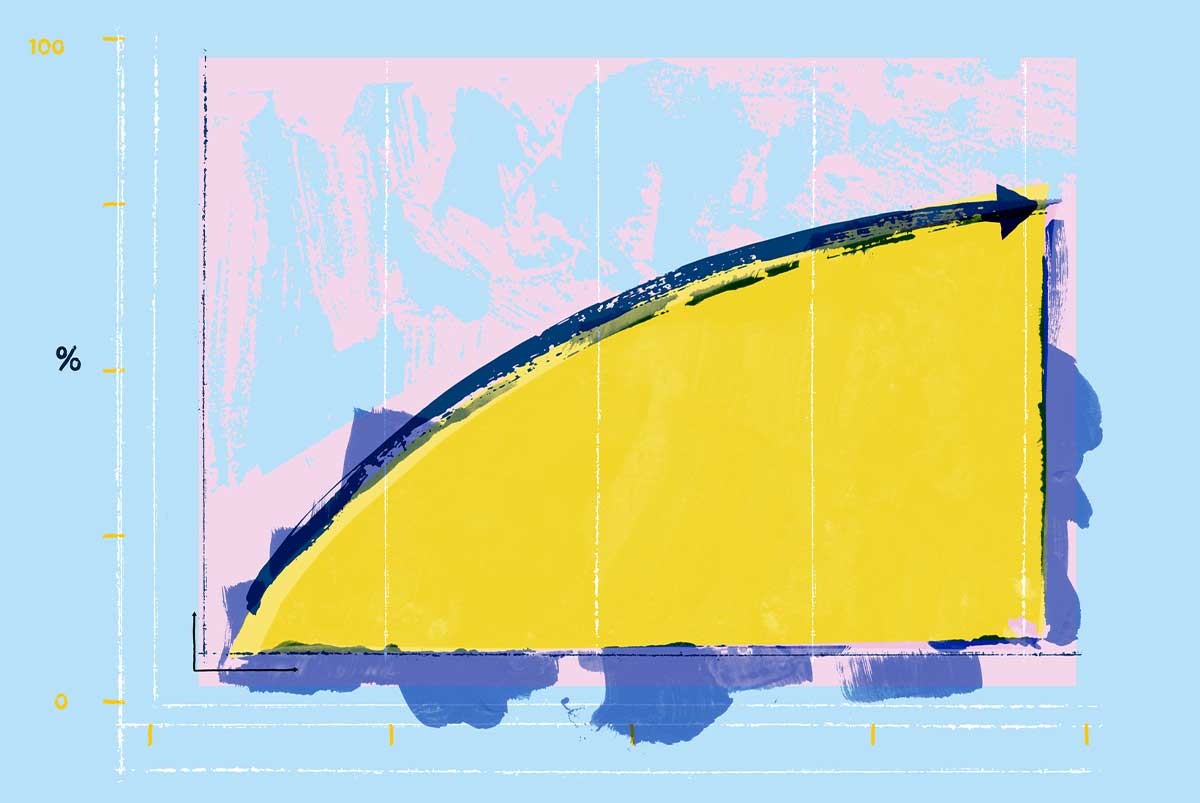Ready To Buy a Home?
Get Approved to Buy a Home
Rocket Mortgage® lets you get to house hunting sooner.
If you use it right, debt can afford you some of life’s greatest purchases – a dream home or your own set of wheels. But debt comes at a price. The price of debt is interest, and interest is the price you pay to borrow money.
Normally, the amount you owe on a loan gets smaller each time you make a payment. If you owe more on your loan at the end of each billing cycle, that’s negative amortization.
It can be difficult to manage and escaping that cycle of debt will take a lot of work.
When you take out a loan, like a mortgage loan, besides getting the money you need to make your purchase, you also agree to pay off the loan for years, often for as long as 30 years.
During the first few months, it might feel satisfying to see how well you’re keeping up with the loan’s payment schedule. But maybe you start to notice that your balance is either holding steady or going up.
Your balance might not be dropping the way you expect because negative amortization is applying your payments toward a portion of the interest rather than toward the loan’s principal (aka the amount you borrowed).
Understanding this will be the key to reducing what you owe and making the most of your monthly loan payments.
What Is Negative Amortization?
Negative amortization is a quirk in the way compound interest works.
When you take out a loan, you agree to pay back the amount you’ve borrowed plus interest. What you owe in interest is determined by your loan’s interest rate. It gets added to your monthly payment, producing the bill you pay each month.
Some types of debts, like credit cards, allow you to make a minimum payment each month instead of paying off the entire bill.
Sometimes mortgages have a similar payment structure, only requiring minimum payments to stay current on your home loan. If the minimum payment you make is less than the amount of interest accrued over the previous billing period, the next month’s balance might be higher when the next cycle’s accrued interest gets added to the amount owed.
This is how mortgagees can pay on time every month yet still owe more and more.
While this situation is problematic, it’s important to know that this isn’t the norm with conventional mortgage loans.
By opting for a mortgage loan that allows you to make smaller payments, but doesn’t cover the entire interest amount, you risk paying more over the long term. In the short term, you might be saddling yourself with a problem when you need to refinance or sell because you’ll owe more than the home is worth. Thanks to the cumulative effect of negative amortization, you won’t be able to build equity because of your growing loan balance.
How Does a Negatively Amortizing Loan Work?
Negative amortization primarily happens when the interest charged on the mortgage is higher than the payments made by the borrower.
It can also happen if the terms of the loan allow for partial interest payments rather than requiring payment of the interest accrued each cycle. That’s the case with balloon mortgages and other negative amortization loans.
Some of these loans allow you to either make short payments (aka partial payments) or defer payments till the end of a year. At the end of the year, you’re expected to make a final, large “balloon” payment to cover any missed or partial payments.
This is often done with mortgages taken out on investment properties, like houses that will be flipped or rented out.
This financing option frees up your cash flow in the beginning – but watch out. It could tighten its grip on your money if interest rates or your financial situation changes unexpectedly.
Types of negative amortization loans
One of the most common types of negative amortization loans is a deferred-interest mortgage. Borrowers can put off making monthly interest payments for a period that may last up to several years.
This can become an issue if your payments aren’t covering the interest that is being added to your balance each month.
Loans that feature a negative amortization option include the payment option adjustable-rate mortgage (ARM). It allows you to determine how much of each month’s payments will go toward interest.
A graduated-payment mortgage (GMP) is another option. With this loan option, the payment that’s allocated to interest increases over time to chip away at that balance. The interest burden on this can get really expensive so make sure you’ll be able to afford it.
Example of How Negative Amortization Works
To understand negative amortization, it helps to work through an example. Warning: We’re about to nerd out. If you don’t want the gritty details, skip to the next section!
We’ll start with how regular amortization works. For this example, we’ll use a $250,000, 30-year mortgage at a fixed interest rate of 4%. We’ll just look at the first year of payments.
A regular amortization for the first year of payments would look like this:
| Month | Principal Paid | Interest Paid | Remaining Balance |
| 1 | $360 | $833 | $249,640 |
| 2 | $361 | $832 | $249,278 |
| 3 | $363 | $831 | $248,916 |
| 4 | $364 | $830 | $248,552 |
| 5 | $365 | $829 | $248,187 |
| 6 | $366 | $827 | $247,821 |
| 7 | $367 | $826 | $247,453 |
| 8 | $369 | $825 | $247,085 |
| 9 | $370 | $824 | $246,715 |
| 10 | $371 | $822 | $246,343 |
| 11 | $372 | $821 | $245,971 |
| 12 | $374 | $820 | $245,597 |
In this example, your monthly payment (principal + balance) would be around $1,193 every month. As you can see, you’re slowly chipping away at your remaining balance and building equity.
To show how negative amortization works, say your mortgage lender allows you to only pay $100/month for the first year. This isn’t enough to make much of a dent in the monthly interest. None of this payment will go towards principal, and any unpaid interest will be added to your remaining balance.
On top of that, interest will be charged on the new, higher balance each month, so how much you owe will grow. A 4% interest rate breaks down to 0.33% monthly.
Here’s how this works:
| Month | Payment | Total Interest Charged | New Remaining Balance |
| 1 | $100 | $825 | $250,000.00 |
| 2 | $100 | $827.39 | $250,725.00 |
| 3 | $100 | $829.79 | $251,452.39 |
| 4 | $100 | $832.20 | $252,182.19 |
| 5 | $100 | $834.61 | $252,914.39 |
| 6 | $100 | $837.04 | $253,649.00 |
| 7 | $100 | $839.474 | $254,386.05 |
| 8 | $100 | $841.91 | $255,125.52 |
| 9 | $100 | $844.36 | $255,867.43 |
| 10 | $100 | $846.82 | $256,611.80 |
| 11 | $100 | $849.28 | $257,358.62 |
| 12 | $100 | $851.76 | $258,107.90 |
Every month that $100 payment is subtracted from the total interest charged and the remaining is added to the balance. Then interest is accrued on the new balance, raising the amount of interest charged for the next month.
As you can see, with negative amortization, if you only paid $100 a month for the first year of your mortgage, the amount you owe would grow by over $8,100.
Special Considerations for Negatively Amortizing Loans
It goes without saying that people don’t sign up for negatively amortizing loans because they want to fall into a debt trap. Under the right circumstances, these can be good loan products for many borrowers.
If you have limited resources or you’re borrowing close to your maximum, this kind of borrowing can be dangerous.
Thanks to their low initial payments and short-term savings during the initial phase of the loan, negative amortization loans often look quite good on the front end. But the long-term consequences can cost a lot more than you were expecting down the line.
How Can You Avoid Negative Amortization?
There are ways to stay current on your payments and make sure you’re building equity instead of a compound interest nightmare.
First, you can avoid negative amortization by carefully reviewing every credit or loan document you’re thinking about signing. Be wary of deferred or minimum payment options and make sure there are no balloon payments.
Another way to avoid balloon payments is to always pay the interest due during each payment cycle. If you can afford it, make a few extra payments and shave away at the principal balance. If you decide to make extra payments, check your loan agreement for a prepayment clause. You’ll want to make sure that you’re not exceeding your prepayment limit, so you can avoid prepayment fees.
Now You Can Borrow Wisely
You’ll wind up owing more than you bargained for if you let your interest payments pile up.
Use credit cards, student loans and home mortgages to live your best financial life. Good debt gets you something worthwhile that increases in value over time. Bad debt is expensive and leaves you with items or assets that weren’t worth the investment.
To make sure your good debt doesn’t go bad, understand the terms of your loan, stick to your budget and make sure your payments – which should include both interest and principal – reduce the loan’s balance.
Get approved to buy a home.
Rocket Mortgage® lets you get to house hunting sooner.
The Short Version
- Negative amortization is when interest adds more to your debt than your monthly payments wipe off
- This happens when you choose a loan payment option that partially pays off interest, even if it’s only in the initial stages of the loan
- While it can be beneficial in the short term, it can land you in much more debt down the road
National Conference of State Legislatures. “Mortgage Lending Practices.” Retrieved November 2021 from https://www.ncsl.org/research/financial-services-and-commerce/mortgage-lending-practices-state-statutes.aspx




